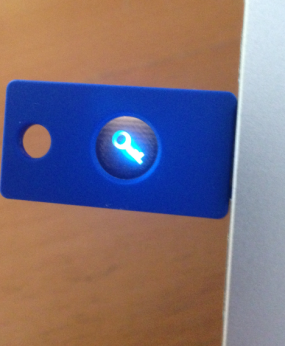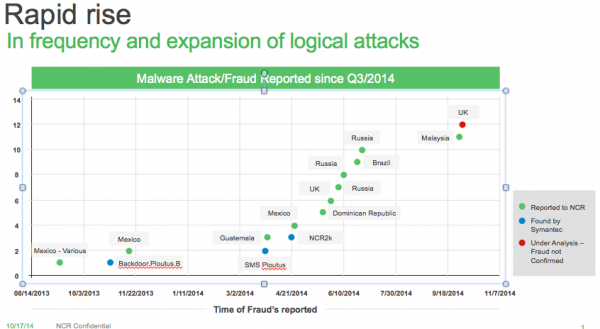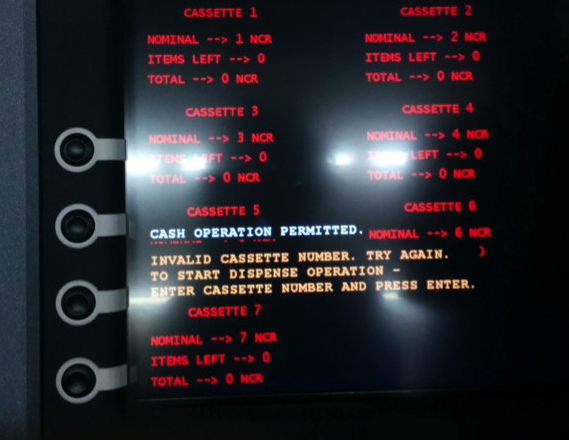The Obama administration recently issued an executive order requiring that federal agencies migrate to more secure chip-and-PIN based credit cards for all federal employees that are issued payment cards. The move marks a departure from the far more prevalent “chip-and-signature” standard, an approach that has been overwhelmingly adopted by a majority of U.S. banks that are currently issuing chip-based cards. This post seeks to explore some of the possible reasons for the disparity.
 Chip-based cards are designed to be far more expensive and difficult for thieves to counterfeit than regular credit cards that most U.S. consumers have in their wallets. Non-chip cards store cardholder data on a magnetic stripe, which can be trivially copied and re-encoded onto virtually anything else with a magnetic stripe.
Chip-based cards are designed to be far more expensive and difficult for thieves to counterfeit than regular credit cards that most U.S. consumers have in their wallets. Non-chip cards store cardholder data on a magnetic stripe, which can be trivially copied and re-encoded onto virtually anything else with a magnetic stripe.
Magnetic-stripe based cards are the primary target for hackers who have been breaking into retailers like Target and Home Depot and installing malicious software on the cash registers: The data is quite valuable to crooks because it can be sold to thieves who encode the information onto new plastic and go shopping at big box stores for stuff they can easily resell for cash (think high-dollar gift cards and electronics).
The United States is the last of the G20 nations to move to more secure chip-based cards. Other countries that have made this shift have done so by government fiat mandating the use of chip-and-PIN. Requiring a PIN at each transaction addresses both the card counterfeiting problem, as well as the use of lost or stolen cards.
Here in the States, however, the movement to chip-based cards has evolved overwhelmingly toward the chip-and-signature approach. Naturally, if your chip-and-signature card is lost or stolen and used fraudulently, there is little likelihood that a $9-per-hour checkout clerk is going to bat an eyelash at a thief who signs your name when using your stolen card to buy stuff at retailers. Nor will a signature card stop thieves from using a counterfeit card at automated payment terminals (think gas pumps).
But just how broadly adopted is chip-and-signature versus chip-and-PIN in the United States? According to an unscientific poll that’s been running for the past two years at the travel forum Flyertalk, only a handful of major U.S. banks issue chip-and-PIN cards; most have pushed chip-and-signature. Check out Flyertalk’s comprehensive Google Docs spreadsheet here for a member-contributed rundown of which banks support chip-and-PIN versus chip-and-signature.
I’ve been getting lots of questions from readers who are curious or upset at the prevalence of chip-and-signature over chip-and-PIN cards here in the United States, and I realized I didn’t know much about the reasons behind the disparity vis-a-vis other nations that have already made the switch to chip cards. So I reached out to several experts to get their take on it.
Julie Conroy, a fraud analyst with The Aite Group, said that by and large Visa has been pushing chip-and-signature and that MasterCard has been promoting chip-and-PIN. Avivah Litan, an analyst at Gartner Inc., said MasterCard is neutral on the technology. For its part, Visa maintains that it is agnostic on the technology, saying in an emailed statement that the company believes “requiring stakeholders to use just one form of cardholder authentication may unnecessarily complicate the adoption of this important technology.”
BK: A lot of readers seem confused about why more banks wouldn’t adopt chip-and-PIN over chip-and-signature, given that the former protects against more forms of fraud.
Conroy: The PIN only addresses fraud when the card is lost or stolen, and in the U.S. market lost-and-stolen fraud is very small in comparison with counterfeit card fraud. Also, as we looked at other geographies — and our research has substantiated this — as you see these geographies go chip-and-PIN, the lost-and-stolen fraud dips a little bit but then the criminals adjust. So in the UK, the lost-and-stolen fraud is now back above where was before the migration. The criminals there have adjusted. and that increased focus on capturing the PIN gives them more opportunity, because if they do figure out ways to compromise that PIN, then they can perpetrate ATM fraud and get more bang for their buck.
So, PIN at the end of the day is a static data element, and it only goes so far from a security perspective. And as you weigh that potential for attrition versus the potential to address the relatively small amount of fraud that is lost and stolen fraud, the business case for chip and signature is really a no-brainer.
Litan: Most card issuing banks and Visa don’t want PINs because the PINs can be stolen and used with the magnetic stripe data on the same cards (that also have a chip card) to withdraw cash from ATM machines. Banks eat the ATM fraud costs. This scenario has happened with the roll-out of chip cards with PIN – in Europe and in Canada. Continue reading










![The 2pac[dot]cc credit card shop.](https://krebsonsecurity.com/wp-content/uploads/2014/10/2packcc-285x173.png)
![2pac[dot]cc's apologetic message to would-be customers of the credit card fraud shop.](https://krebsonsecurity.com/wp-content/uploads/2014/10/2pacgone-600x104.png)


